November 26th, 2013 § § permalink
As the term is coming to an end, there is no better time to reflect upon the past three months in COMM 465. The class has been one of the most interesting I’ve taken to date, with many real life examples and cases that have made theories and content relatable to ‘real life’. Having done a few marketing internships, I only wish I had taken the course sooner! Of all the important lessons learnt however, one very valuable lesson learnt was learning how to work effectively in a team in the course of completing three group assignments.
First of all, I couldn’t have asked for a better group to work with. Everyone was equally invested in the assignments and had a strong desire to do well in the class. Everyone was in attendance at all group meetings, and was always eager to contribute and discuss ideas. Not many people can say that they thoroughly enjoyed working with their teams, but I can!
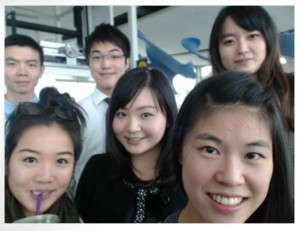
Looking back, I just wish there was more time to explore everyone’s ideas. But just as in the real world, where projects are often constrained by time, we did not always have the time to sit through and discuss each individual’s ideas in depth to make sure we met the deadlines. This also sometimes involved going with ideas that were less time consuming instead of more creative options that required more time. This is especially the case for the video, where Alex had the idea to include some form of animation in our video which would no doubt give us points for creativity, and overall, make our video more interesting. But unfortunately, as none of us has much expertise in animation, creating something like that would be far too time consuming.
Though working on Assignments 1 and 2 were a little shaky at first as we struggled a little with getting organized, we were experts at this by Assignment 3, systematically coming up with a script to filming to editing of the video. And that is also another key lesson learnt: be organized! Having all of one’s ideas sorted out from the beginning saves a lot of time and hassle going back and forth to make sure the entire project flows and is line with the guidelines.
So overall, I would say the WestJet team did a great job working together and I took away many things from this experience, including learning to communicate effectively with others, being organized… and five amazing friends!

(Looking at this photo, I’ve also learnt that I should really work on looking better in photos.. it’s probably time to update my LinkedIn profile… : /)
November 21st, 2013 § § permalink
I recently came across a post on the Harvard Business Review Blog Network on JC Penney’s failed marking strategy back in 2012.

JC Penney came up with a strategy to get rid of all discounts and sales, and to only have prices that reflected the true value of its products and merchandise year-round .While it all sounds very attractive at first, the numbers showed that this strategy failed miserably with more than a 20% decline in sales.
Author Alexander Chernev, also a professor of the Kellogg School of Management at Northwestern University, suggests a number of interesting reasons behind JC Penney’s failure.
The reason I agree with most is that JC Penney failed to meet the expectations of its customers with its new marketing strategy. JC Penney had a reputation for having amazing sales with great discounts. Many of its customers were accustomed to this. Furthermore, Chernev argues that sales events often creates additional value for many customers. Some will be able to identify with the feelings of excitement one might get from purchasing an item for 50% off. Somehow purchasing the same item for the same price without the discount is just less satisfying. Getting rid of sales and discounts at JC Penney effectively lowered the value of shopping at JC Penney for customers.
An article by The Huffington Post touches on the same issue, reporting that ex-CEO Ron Johnson severely overlooked how much customers valued and enjoyed sales and using discount coupons.

Clearly, Johnson didn’t understand his customers enough and failed to realise that sometimes, customers are human and do not always display the most logical behaviour. Although, technically, the new strategy offered fairer and lower pricing. Customers did not take the bait.
Something Chernev didn’t touch on which I thought some customers of JC Penney would feel was perhaps a sense of being cheated. If I were a long-time customer of JC Penney who has consistently patronized the store for years and they suddenly enacted this strategy, slashing prices by 40% across the board to reflect the “true value” and price of merchandise… wouldn’t this mean that I had been overpaying for all my merchandise from JC Penney over the past years? I would certainly feel quite upset that I had been effectively “overcharged” throughout the years and would seriously reconsider shopping there again.
November 21st, 2013 § § permalink
Starbucks is perhaps one of the best at delivering value to its customers. I’ve travelled to a number of cities in the past year, from Istanbul to Hong Kong, and can’t recall one time I wasn’t able to find a Starbucks when I was craving a coffee.
Truth be told, Starbucks probably doesn’t serve the best coffee around, but it’s reliable, always there when you need it.
They are masters at delivering value, locating their stores in areas with highest traffic, in the most convenient spots where most would want to grab a coffee- subway stations, malls… the list is endless.
One might think there isn’t anything else they can do to improve on delivering value to customers.
Ever wanted to buy someone a coffee but it was too inconvenient to carry it all the way to them or was worried it was going to get cold by the time you got it to them?
You can now deliver a coffee to someone through a tweet.
I thought this was genius. Coffee, in itself, is a great gift. I know it would brighten my day if someone got me a coffee, but delivering a gift like this can be a logistical nightmare. When would this person ideally prefer to have their coffee? Would it spill along the way as I brought it to them? How much cream or sugar would they like in their coffee?
Buying someone a coffee through twitter gets rid of all this problems while still delivering the value of a nice, hot cup of coffee from sender to receiver!
Make this available in Canada, already!
November 20th, 2013 § § permalink
Jell-O has been a popular and favourite dessert amongst North Americans for decades. It’s even the official state snack of Utah in the U.S. They come in a variety of colours and flavours, such as strawberry or lime.


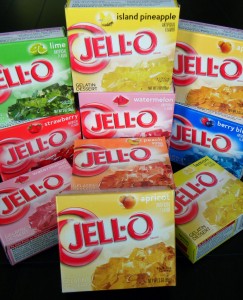
But did you know, that in the 1960s, in attempt to capitalize on the popularity of healthy eating, Jell-O came up with a new product. Jell-O noticed the trend of consumers increasingly shifting to healthier food options in the 60s, especially gravitating towards salads and hence came up with this gem. The product came up in flavours such as ‘seasoned tomato’, ‘mixed vegetable’ and ‘celery’ (ugh).
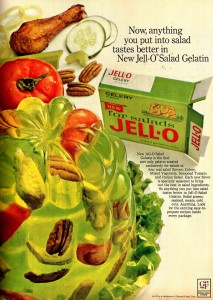

The product has since been discontinued but based on past articles and advertising, it appears that the way to consume this vegetable flavoured Jell-O was to throw in various vegetables into the Jell-O mix, chill it and then serve.
What perplexed me was whether this was an example of the broadening or deepening of Jell-O’s product line. In essence, this was merely a different flavour of Jell-O produced. I first concluded that this should be an example of the deepening of a product line. Upon further thought however, the way the product was consumed and marketed was different from the rest of its products which consisted mainly of sweet and fruity flavours which was meant to be consumed as a dessert or snack. Vegetable Jell-O, on the other hand, was savoury and meant to be consumed as part of one’s meal.

Yum?
Unable to come to a conclusion, even after discussion with some of my Marketing classmates, Maggie and Nicole, I consulted the instructor, who advised that one should not merely focus on the new product, but the complete spectrum of products offered by the company to determine if this was the broadening or deepening of a product line.
As Jell-O mainly offers gelatin and pudding based products, it would seem reasonable to conclude that the offering of vegetable Jell-O was the broadening of its product lines. However, if Jell-O were to offer a wide variety of product including say chips, and other snacks, this would be the deepening of its geltain product line.
Therefore, when confronted with similar issues, one should look at the new product relative to all the products the company offers.
November 2nd, 2013 § § permalink
The UBC SUB typically has a row of booths lined down the middle of the ground floor, selling gloves, scarves, simple jewelry and phone accessories. However, last week, I noticed a booth I had never seen before, selling very elaborate statement necklaces.

A friend I was with was particularly captivated by the elaborate attention-grabbing display so we stopped to take a look. After browsing for a bit, we enquired about the prices of a few pieces. The price range of these necklaces were from about $100 to $ 180. I couldn’t help but comment how pricey the necklaces were to the owner of the booth who simply smiled and replied, “Yes, they are a little on the pricey side”. Needless to say, both my friend and I left without making a purchase.
I wonder if the business owner would have been more successful if she had taken a class in marketing.
Though not particularly attracted to these elaborate necklaces myself, my more fashion-forward friend remarked to me later on that these necklaces were extremely trendy right now. While not suitable for everyday campus fashion, she remarked that she would definitely have use for a similar necklace on a night out, or even at a nice dinner with friends. Thus, although I did not see this at first, the product probably had value to the many fashion-savvy female students on campus.
However, the prices of these necklaces were far too exorbitant for the average university student. The average student would be able to buy a textbook or have at least ten meals for that same amount of money. Even if the prices of these necklaces were justified, say if they were hand-made, exclusively imported or one-of-a-kind, the booth owner failed to communicate any of this information even when directly questioned to convince her customers that these necklaces were worth their hefty price tag. A quick check on the internet on popular fashion sites revealed that similar necklaces could be purchased for much cheaper at less than $10 at Forever 21.
Lastly, while retailing these necklaces at the SUB made some sense due to high volumes of female students passing through, the SUB is definitely not the place to be retailing expensive merchandise. I might have been more attracted to these necklaces if they were retailed at boutique store in Gastown, especially given the price. The fact that they were on display at the SUB made me feel like the business owner was just looking to make a quick buck of naïve students since the set up of the retail location was all quite modest for an item so extravagant.
October 29th, 2013 § § permalink
After reading Valeria’s post on Coca-Cola, I was intrigued by Coke’s marketing efforts and their new line of green coke in Argentina. I did a little more reading and uncovered that the soda giant has also been pushing a new line of Coca-cola that comes in ice bottles in Colombia. The selling point of these glass bottles is that no waste gets left behind after the soda has been consumed, and the bottle melts away to water.
It appears that Coca-Cola is really making an effort to keep up with the growing social trend of greener consumption. Not particularly well-read or aware of conservation and green consumption trends in Southern America, I decided to try and find more information about the topic. However, nothing substantial came up in my research. Thus, I find it intriguing that Coca-Cola would launch these greener products in regions not particularly well-known for its priorities in green consumption.
Nevertheless, both products seem to be doing pretty well in these markets, reportedly selling almost 300 bottles an hour in Colombia. If Coca-cola has plans to expand this product to other markets, I have no doubt that these greener products would do well in North America where consumers are more active in environmental conservation and green consumption. Furthermore, I am sure that many people will purchase a few bottles of each product out of pure curiosity. I know won’t be able to resist!
October 28th, 2013 § § permalink
Bonny Doon Vineyard, a winery based in Santa Cruz, is well regarded as a pioneer in its industry.
Its remarkable story is an inspiring one in market development.
About twenty years ago, wine had a somewhat grandiose image in North America. Perhaps due to its European origins as well as exorbitant price compared to other types of alcohol. Wine was perceived to be typically consumed by the “cultured” or those of a certain social class. Wine had the image of being a drink you ordered to accompany your $200 steak on a night out.
While wine-makers were able to charge high prices for their wines, their market size was effectively quite limited. The average North American consumer had preference for cheaper and more accessible alcoholic beverages. Wine was deemed too complicated or inaccessible. Red or white? Pinot noir or Chardonnay? It seemed much easier to just grab a beer. Fuss free.
Then along came Bonny Doon and its enigmatic founder, Randall Grahm, who single-handedly deconstructed the “pretentious” and complicated image of wine consumption. Through creative and humorous wine labels and lower prices, he made wine more approachable and accessible to the average everyday American, effectively opening up the market for himself. In addition, Bonny Doon positioned itself in a completely untapped market of everyday Americans who previously did not feel comfortable with wine. It was definitely a risky and bold move on Randall Grahm’s part, but this proved to pay off in the end.

Bonny Doon’s Big House Red Wine
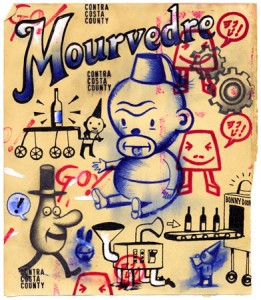
Another of Bonny Doon’s creative wine labels

A conventional bottle of wine
Instead of trying to compete in the already saturated wine industry in California, Grahm was able to identify an opportunity in the market that allowed him to position himself in the industry without facing the existing stiff competition. This probably explains why Bonny Doon was one of the fastest growing wineries in the 90s, experiencing record growth in sales and remains as one of the most well-known wineries in California today.
October 5th, 2013 § § permalink
Ringdingding, apparently.
The above video went viral in September, with over 88 million videos to date. It is a music video, conceptualized and performed by a comedy duo from Norway, Ylvis. Ylvis have claimed that the purpose of the video was to entertain viewers of their talk show in Norway. The video, was by no means, meant to be a marketing tool. However, the video has been extremely successful in generating interest in their talk show all across the globe, particularly in North America.
What intrigued me was the video’s ability to generate interest in Ylvis’s talk show despite it bearing almost no relation or reference to said talk show.
Many organisations spend thousands of dollars on elaborate marketing strategies and advertising tools, in hopes of generating interest in their product or services. A lot of research goes into understanding the behaviour and preferences of target markets, strategies are then formulated over several months, and finally, thousands of dollars spent in execution.With no means to discredit Ylvis… Although I am sure much thought went into producing their video, I am certain that the video was produced without any elaborate research or strategy in mind. And yet, the publicity they achieved is only what many organizations can dream of.
The video, in my opinion, makes no sense albeit raising the interesting question of “what does the fox say?”. But its high entertainment value was extremely successful in capturing the attention of over 88 million views, and subsequently views for their talk show. This is but one example of how pure entertainment value can help generate buzz for one’s brand.
Perhaps Ylvis simply possess a very subtle understanding of today’s audience, and were able to craft this hilarious video to capture our attention.
An intentional promotional tool or not, all I know is the catchy song and video will be stuck in my head for weeks to come, and I am sure I’m not the only one.
October 3rd, 2013 § § permalink
In continuation of last post on using 9-11 as an advertising/ promotional platform, I came across the following video from the New York City Ballet.
In my opinion, it is not all too different from that AT&T tweet. Both made use of 9-11 to promote their products.
However, reaction to the above video was starkly different from that to AT&T’s tweet. Comments on the video called it “moving”, “touching” and “beautiful”. I could not identify a single comment, calling out NYC Ballet for using 9-11 as a platform to promote their company.
It is interesting how consumer perception can vary so drastically in accordance to different forms of branded content. I believe AT&T’s tweet and the NYC Ballet’s YouTube video provide a good contrast, and is an excellent example to all marketing and advertising associates of how a little more thought put into an ad could really make a difference in building or breaking one’s brand.
September 21st, 2013 § § permalink
Multinational telecommunications provider, AT & T, recently came under fire for a tweet they made out from their official Twitter account. The tweet featured a hand holding up a smartphone, capturing a photo of The Tribute in Light (an art instillation in remembrance of the September 11 attacks), alongside the caption “Never Forget” on the anniversary of 9-11.
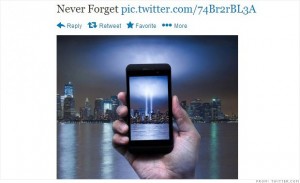
(Source: CNN Money)
AT&T defended themselves in the aftermath of a slew of negative feedback, stating that the tweet was not intended to be any form of product placement or advertising, but merely their way of remembering the fallen of 9-11.
I have to say I remain skeptical of the claims.
While I might believe that AT&T were not trying to blatantly convince consumers to purchase a smartphone or join their network through the photo, I do think marketing executives were trying to achieve something more subtle. I can definitely see how a marketing executive at AT&T would have thought that the tweet would have been a good way to portray AT&T as a truly patriotic American company.
9-11 remains a sensitive date for many Americans, and the emotions associated with this day remain strong. It seemed to me that AT&T was trying to capitalize on these strong emotions of patriotism, hoping that Americans will associate these feelings with the AT&T brand, through the photo.
While I would give some credit to the marketing team for identifying an opportunity to strengthen AT&T’s brand image, I echo the opinion of many social media users that the the tweet was distasteful. It is disappointing that AT&T failed to exercise more sensitivity and discretion on 9-11.
That being said, how could AT&T have done things differently?
In my opinion, reactions could could have been vastly different if AT & T had simply chosen to tweet a photo of The Tribute in Light, omitting the smartphone. Had this been done instead, I think AT&T could have achieved its goal of generating a more patriotic and positive brand image without the negative feedback.
I do believe that it should be considered unethical as long as there is any intention to capitalize on any tragedy for brand promotion.However, from a marketing standpoint, what only truly matters is consumers’ perception, and not the company’s intention. As long as the company manages to convince consumers that they are not participating in any blatant form of marketing, I believe the reaction would have been much more positive.
It is unfortunate that the poorly thought out tweet made by AT&T did quite the reverse of what it hoped to achieve. Instead of being seen as a patriotic American organization, consumers now perceive the company to be just another selfish, profit-driven company.Maintaining an ethical image is crucial to creating brand loyalty. I think AT&T has definitely lost the trust of a number of consumers because of this one tweet.
The negative repercussions have been quite drastic. In fact, social media users have sparked a new hashtag, poking fun at the company. To read more and be entertained by a series of hilarious tweets, click here.














